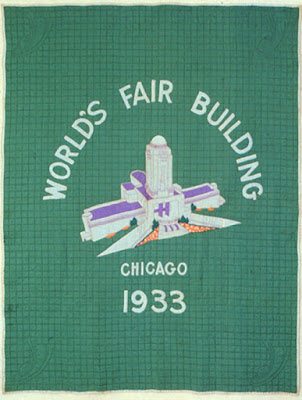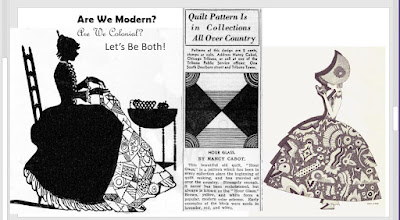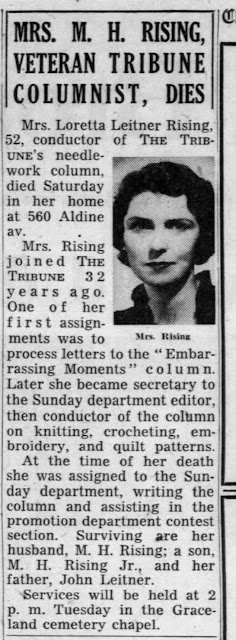The gang at Accuquilt has invited me to give a short lecture
on quilt history today about a new die for their cutting machines.
Click here:
(October 4, 2022 Noon Central Time)
Here's some background on my discourse.
Quilt show at Carson Pirie Scott, January, 1933
Chicago in 1933 was home to a quilt mania.
Illinois Historical Society
Quilt entered in a contest at the 1933 Fair
The Chicago Tribune saw an opportunity for a popular column selling patterns, assigning Needlework Editor Loretta Leitner to publish a regular feature under the pen name Nancy Cabot, beginning in January.
1935 standard image of a New England colonial maid
in a ladder-back chair with a braided rug just finishing
up a "Colonial quilt."
Loretta Leitner Rising (1906-1958)
Over the next five and a half years the column published hundreds of patterns.
Scrapbook of Nancy Cabot patterns
May 22, 1935
Nancy Cabot was in tune with these Colonial Revival images, giving
trend followers mixed messages about whether they should
be looking forwards or backwards.
For example, "Red Shields" is the odd name she gave this overall triangle pattern.
I bet she made a lot of those names up.
In 1938, pattern historian Wilene Smith tells us, the Cabot column changed sources from the Tribune building to New York syndicate Peerless Fashion Service. It all gets quite confusing after 1938.
Whether she continued producing the Nancy Cabot column or not, Loretta Leitner continued with the Tribune till her death in 1958. She wrote for the Sunday Department, creating needlework features like this one under her own name in the 40s.
We don't know much about her personal life. She was a Chicago native whose first job when she joined the paper about 1926 was processing letters to the "Embarrassing Moments" column. She married Morris Herbert Rising but never used his name in her career, remaining Loretta Leitner. She had one son Morris Jr.








.jpg)
.jpg)








"undistinguished by historical accuracy" LOL
ReplyDeleteHer historical accuracy reputation hit the skids when I saw poinsettia and Hawaiian missionary in the same sentence. At least the quaint but wrong image of patterns used in colonial times is sort of believable.
ReplyDeleteDIdn't you comment in the past about whether or not some of her designs were actually sewable? Or were at very least so complicated that they were never made into a quilt? Or was that another blogger I read, or another designer that was widely published back then???
Both nancy and Alice brooks designs were often diabolically complicated....graphic artists designing needlework.
Delete